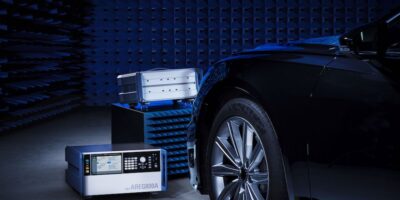Driving scenarios for testing radar based advanced driver assistance systems (ADAS) and radar sensors used in autonomous cars are simulated entirely over the air by the Rohde & Schwarz RTS radar test system. The RTS system consists of R&S AREG800A automotive radar echo generator (back end) and the R&S QAT100 antenna array (front end).
Currently, laterally moving objects are simulated by mechanically moving antennae. The R&S RTS replaces the mechanical movement by electronically switching individual antennae in the front end on and off. Even objects moving laterally to the car at very high speed can be simulated reliably and reproducibly, says Rohde & Schwarz. The R&S RTS is able to simulate the radial velocity (Doppler shift) and the size (radar cross section) of objects at user configurable ranges, including very small ranges, adds Rohde & Schwarz. Objects can be represented by cascading multiple R&S AREG800A back ends.
The R&S RTS moves tests currently performed on the road into the lab. This allows early error detection and a significant reduction in costs, claims Rohde & Schwarz.
The number of radar sensors in vehicles is growing, with long range radars required by NCAP (New Car Assessment Program), and an increasing number of corner radars are installed that can also monitor objects moving laterally. The latest generation of radar sensors have integrated RF antennae and signal processors for object recognition on the same chip. That is why the objects to be recognised need to be simulated over the air in radar sensor tests, argues Rohde & Schwarz.
The R&S RTS – consisting of the R&S AREG800A back end and the R&S QAT100 antenna array front end – is a target simulator that generates dynamic radar echoes that can be used at all stages of automobile radar sensor testing – from pre-development through hardware-in-the-loop lab tests to validation of ADAS/autonomous functions integrated in the vehicle.
The back end can simulate a large number of independent artificial objects and dynamically vary their range, size (radar cross section) and radial velocity. With an instantaneous bandwidth of 4GHz between 76 and 81GHz, it covers the typical frequency range of current and future automotive radar sensors.
The front end uses up to 192 independently switchable antennae to simulate objects moving laterally to the car’s direction of movement, providing very fine resolution, high switching speed and high repeatability. Electronic switching of the antennae does not cause any wear to RF cables and other moving parts, as is otherwise encountered with mechanical antenna motion used in traditional test systems. An optional transmit array makes it possible to simulate two objects very close together and moving laterally to the car. The small patch antennae and the absorber-lined surface provide a low-reflection RF front end with a very small radar cross section. This reduces the sensor’s noise floor and suppresses close range targets and potential multi-path reflections. The antenna spacing of just 3.7mm delivers very fine angular resolution. Multiple front ends can be combined to cover larger fields of view of radar sensors. An angular resolution of less than 0.5 degrees is possible.
From simple scenarios such as automatic emergency breaking, the R&S RTS is modular and can be extended to cover very complex scenarios with multiple radar sensors. Any number of R&S QAT100 front ends and R&S AREG800A back ends can be combined. One of the back ends synchronises all the components installed in the set up. A graphical user interface (GUI) with a touchscreen makes it easy to configure the test set up.
For test automation with industry-standard tools, the R&S RTS comes with a hardware-in-the-loop (HiL) interface conforming to the ASAM Open Simulation Interface specification.







